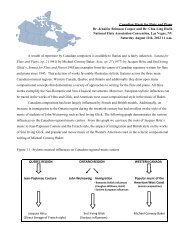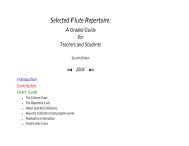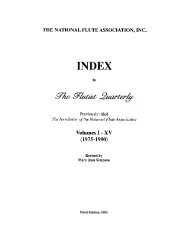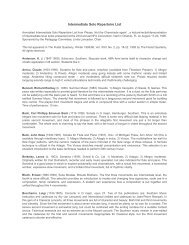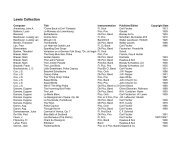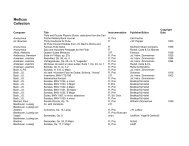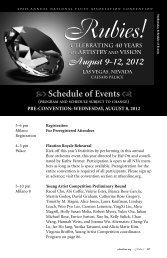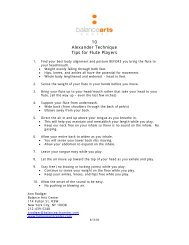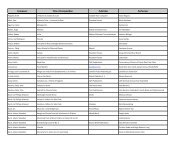Flute Sectionals
Flute Sectionals
Flute Sectionals
Create successful ePaper yourself
Turn your PDF publications into a flip-book with our unique Google optimized e-Paper software.
ii. Same as (i) plus D1-2; Eb1-2 (talk about LH index finger as an “octave key” to<br />
reinforce keeping LH1 up when playing D2 & Eb2 (see p. 45 (3.07), TFSB)<br />
iii. Same as (ii) plus continuing chromatically through F3 or G3<br />
iv. For more advanced students, use full range to C4 or D4; vary articulation<br />
v. Eb Major Scale in Octaves: Eb1-2, F1-2, etc… to Eb2-3<br />
vi. F Major Scale in Octaves; also G, Ab, Bb, depending on level.<br />
g. Activities<br />
i. Low-High tongued, slurred<br />
ii. Use various tonguing and rhythmic patterns, including<br />
1. Snake Charmer ( : LHH x 4 or HLL x 4<br />
2. Donkey ( : LH x 4 or HL x 4)<br />
3. Slurred<br />
4. Fluttertongued<br />
5. Various rhythmic patterns or double-tonguing<br />
6. “Echoing Rhythms”, “Follow the Leader”, “Telephone”<br />
iii. Left-Hand Scales- G Major & Ab Major (TFSB p. 42 (3.04) – Left-Hand Scales)<br />
4. Balancing the <strong>Flute</strong> (Patricia George)/Hand Position<br />
a. Always keep keys level<br />
b. Support point: LH index finger above knuckle on the “flute shelf” (not on bone)<br />
c. Support point: embouchure plate in chin (Patricia George)<br />
d. Support point: RH thumb on back of tube with fingers in their natural arched position (pads of<br />
fingers on the keys, not fingertips); “pulling book off shelf” (Michel Debost)<br />
e. RH thumb is a counterbalance to LH index finger, stabilizing flute so it won’t roll toward the<br />
player when lifting the LH thumb for notes such as C (Patricia George)<br />
f. “Pizza Slice” (Patricia George): end of flute should be in front of your nose<br />
g. Activity: Play B to C; and other notes to C<br />
i. Keep LH still—watch for movement in the elbow and hand<br />
ii. Move fingers from the knuckles and keep elbows quiet (Patricia George)<br />
iii. Eventually use the “I am going home” rhythm (P. George)<br />
h. Aurally (not written): Use note pairs in page 44 Balancing the <strong>Flute</strong> and Trills for Balance<br />
from The <strong>Flute</strong> Scale Book<br />
5. Body Alignment and Music Stands<br />
a. Body is aligned with shoulders above hips—no twisting at waist<br />
b. Stand or sit at 45% angle (1/4 turn to the right) to music stand<br />
c. Standing: feet shoulder width apart with left foot at 12:00, and right at approx. 3:00<br />
d. Shoulders should be down, arms & elbows should hang from shoulders in a natural position—<br />
no tension<br />
e. Head should be balanced on neck with chin “level” (looking straight ahead, not looking down<br />
or up)—exercise to find this balanced spot.<br />
6. Vibrato—with Headjoint only (Patricia George), TFSB, p. 13 (1.01)<br />
a. Using HAH and HAH slurred in chunks<br />
b. 2:1 pattern HAH HAH HAH x 4, then slurred HAHs (vibrato) x 4<br />
c. 3:1 pattern<br />
d. 4:1 pattern<br />
e. Put flute together and apply these patterns to various scales<br />
7. Double-tonguing—with headjoint only<br />
a. 2:1 pattern<br />
b. 4:1 pattern



